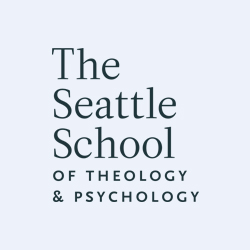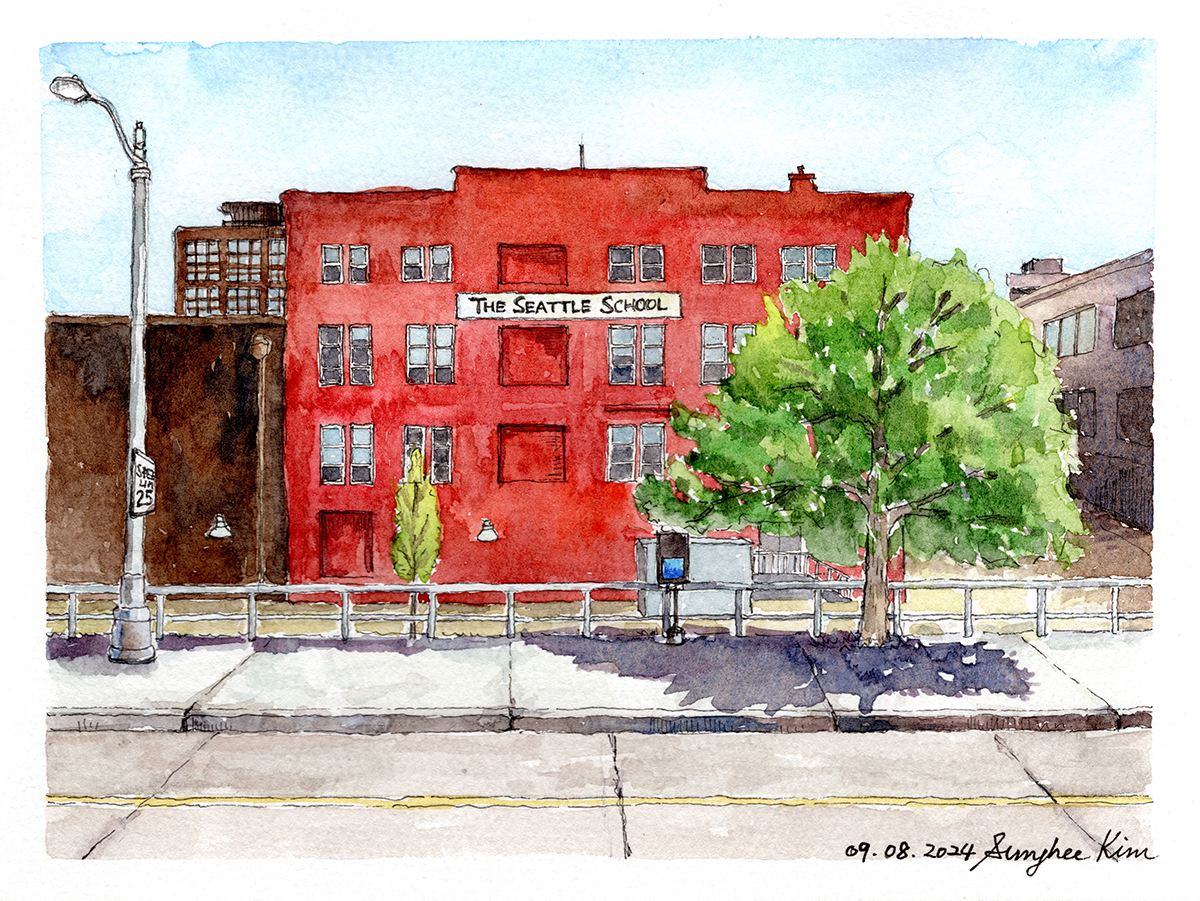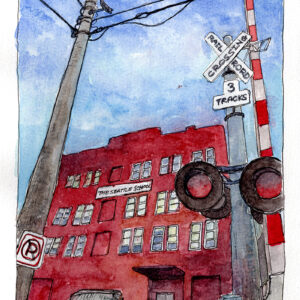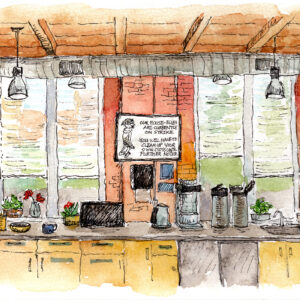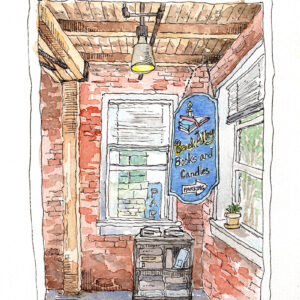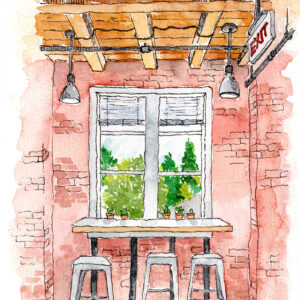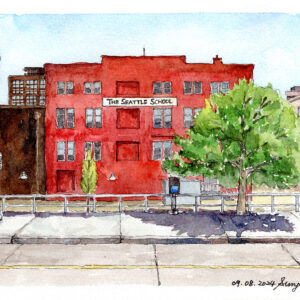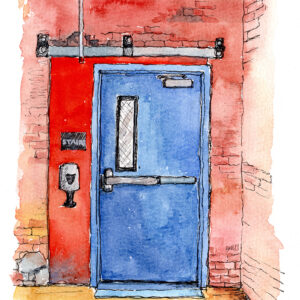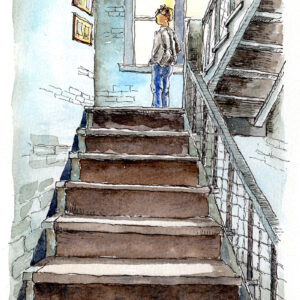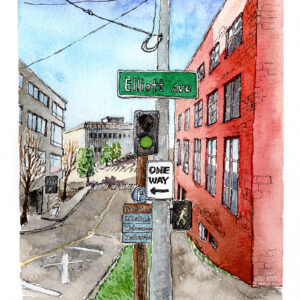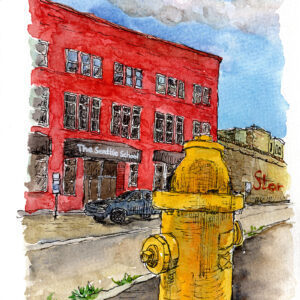Red Brick Building: The Liminal Space by Sunghee Kim
This fall, our second-floor gallery at 2501 Elliott Ave. features watercolors created by Sunghee Kim, a second-year student in the Master of Arts in Counseling Psychology program. Through the Artist Statement and interview below, she shares more about her experiences as a Seattle School student and artist.
Prints of these paintings are available for purchase in the bookstore, with proceeds supporting the BIPOC student group. More information about an online auction for these nine original paintings will be available early in the new year.
Artist Statement:
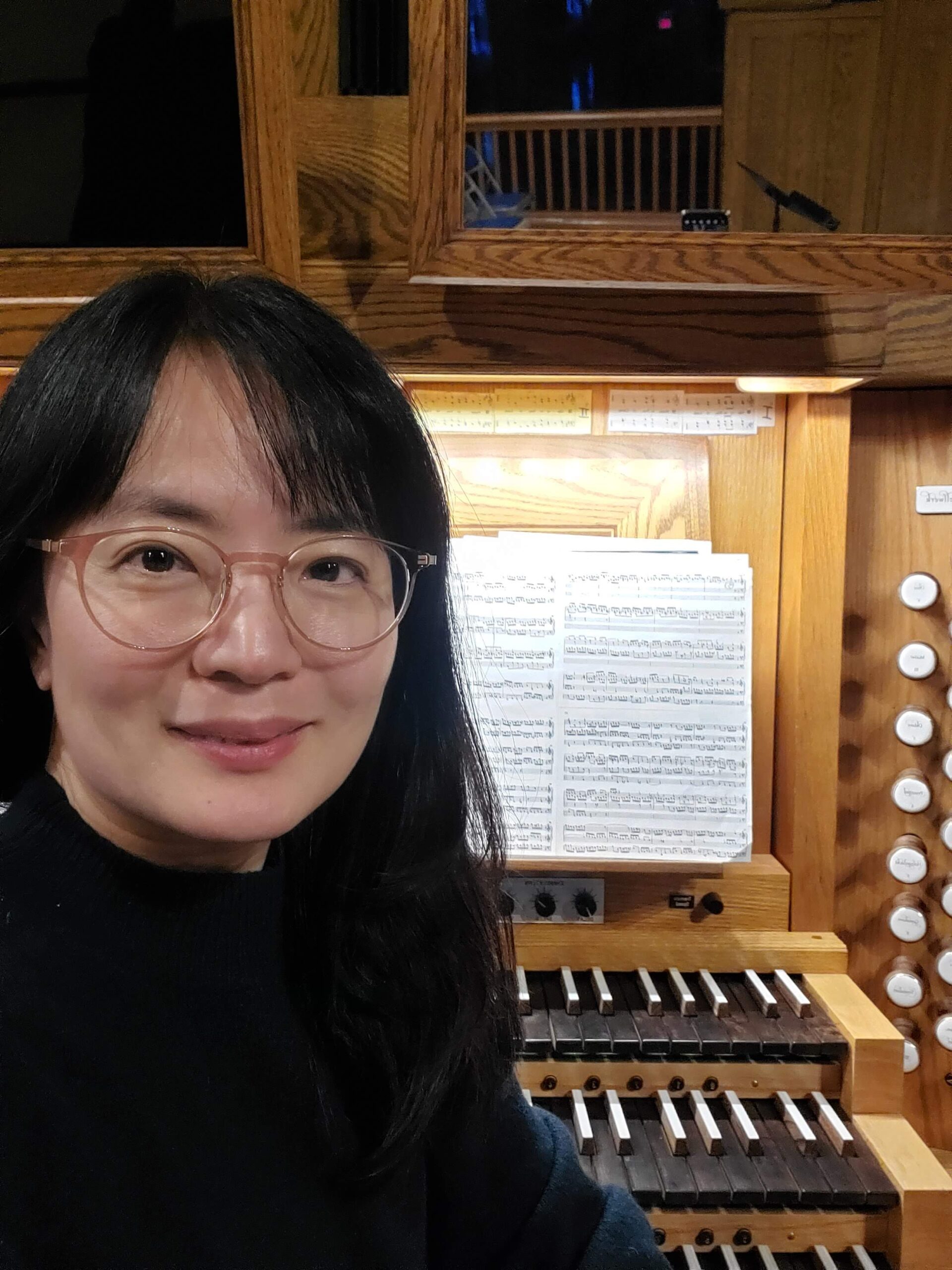 In my first year at The Seattle School, I often sat quietly in the Back Alley in the mornings, watching the blue sky, the water, the trains, and the cruise ships pass by through the window. During these moments, the Red Brick Building became a liminal space for me—a place where I lost track of time, reflected on my past, grounded myself in the present, and held hope for the future. To capture the emotions, joys, and struggles I experienced there, I began drawing and painting the Red Brick Building.
In my first year at The Seattle School, I often sat quietly in the Back Alley in the mornings, watching the blue sky, the water, the trains, and the cruise ships pass by through the window. During these moments, the Red Brick Building became a liminal space for me—a place where I lost track of time, reflected on my past, grounded myself in the present, and held hope for the future. To capture the emotions, joys, and struggles I experienced there, I began drawing and painting the Red Brick Building.
Many thanks to my classmates and instructors who helped and encouraged me to discover my joy in painting. As we prepare to move to a new campus farther south of downtown Seattle, I hope these paintings will evoke memories of joy and gratitude, as well as the struggles and sorrows, for those who shared this space. I hope these paintings inspire people to embrace their own journeys, use their talents, and share their gifts with the world.
What drew you to The Seattle School and how did you choose your degree program?
I thought I knew why I came here, but now that feels like a question for me too, as I keep finding new answers along the way. I’ve always been interested in understanding the human mind, and I also wanted to understand why I was struggling so much to adjust to life here in America, even when I was surrounded by kind people. I’ve seen many of my friends, especially international students and immigrants, struggling in similar ways, but it’s difficult to find someone who is truly willing to listen to our voices. I thought I needed to be the first to listen to my own story, so I could develop my capacity to listen deeply to others. This is one of the many reasons—some still not fully clear to me—why I began studying Counseling Psychology at The Seattle School.
What has been a favorite class at The Seattle School?
So far, I’m both enjoying and challenged by all of my classes. Each one offers so much to learn and work through. Instead of naming a favorite, I’d like to share how certain classes have inspired me to draw and paint.
In the winter term of 2024, I took a course on Narrative, Identity, and Asian American Experiences with Dr. Jermaine Ma. She encouraged us to express our emotions using just three colors with colored pencils or any other art supplies we had. At first, I picked random colors, started coloring, and then gripped the pencil in a sort of rebellious way. I drew lines and circles without any form or order. It felt like something was cracking open inside me, like I was opening a box I didn’t know I had. From that moment on, I kept art supplies close by on my desk, but did not begin drawing or painting. Suddenly, I remembered how much I had enjoyed drawing and painting when I was a kid.
In the same term, I was taking the Critical Learning Lab with Dr. Dwight Friesen, where I frequently heard the term “unlearning.” It prompted me to reflect on how I could become more flexible in letting go of what I was used to doing and believing. So, I decided to approach everything differently, what I called the “stupid way.” I dedicated the most time to the assignment with the least weight on the grade. For the final presentation of my “My Landmark” project, which I had already earned enough points to pass, I spent hours and hours working on it. Instead of using PowerPoint, I hand-drew all the slides for my presentation. After giving the presentation with my own paintings in this class, I got enough courage to paint as a way of expressing my Korean immigrant identity for the final assignment for Narrative, Identity, and Asian American Experiences class. Those paintings were later displayed at the Underrepresented Students’ Voices Gallery throughout spring term and summer at the school.
In the spring term of 2024, I took an elective class called The Artist’s Way with Dr. Pat Loughery. Throughout the course, students were asked to create any kind of creative works, and I decided to try urban sketching, something I had never done before. Then, I ended up painting the Seattle School. Some of the paintings currently displayed at the gallery are pieces I created during this class.
What draws you to watercolor painting?
I do love various, different types of art mediums, but when it comes to watercolor, I particularly love its picky and sensitive personality. Watercolor painting requires a lot of patience. It never allows me to take a shortcut. It is also not forgiving. Once I make a mistake, there’s no going back. So, I have to slow down and learn to accept my mistakes as part of the “Art.”
Another thing I really love about watercolor is its transparency. Sometimes the color on the paper is really bold and vivid, and other times, it’s almost invisible. What I appreciate is that, no matter how strong or faint the color is, it never fully takes over the paper. If you let it cover the whole surface, it loses that delicate, shimmering beauty that makes watercolor so unique. I enjoy this challenging, sometimes even painful, process of creating a watercolor painting.
How did your classmates and instructors encourage you to find joy in painting?
What I really appreciate most is their presence. Instead of offering comments or advice, they were just there with me, spending time and sharing curiosity about my stories. That alone made me feel heard and seen. Once my story was heard by them, I became more curious about what I wanted to express. Their curiosity about me helped spark my own curiosity in various areas. This year, painting became one of the mediums through which I expressed myself.
At this point in time, what would you like to explore after graduating from The Seattle School?
Well, like many students, after graduating, I want to complete the required clinical hours and pass the licensure exam as soon as possible, and eventually secure a stable position as a counselor. But these are just factual steps. At this moment, my main focus is to explore my own picture of the world and to cultivate a deeper curiosity within myself. By doing this, I hope to develop my capacity to see and listen to others’ pictures of the world and their voices more fully. Ideally, I would love to work with people of color, international students, immigrants, and refugees. If I could serve as a blank canvas on which they feel free and safe to express themselves, I couldn’t be happier. The journey I’m on now feels like it’s strengthening me to become like watercolor paper—able to hold water and pigments without warping.
What’s your hope for these Red Brick Building paintings and reproductions?
Initially, I started painting the school building to capture moments of both joy and struggle that I experienced here. To finish just one painting, I’d spend hours looking at the same spot—or a photo of it—over and over. Through that process, I noticed something special happening: an ordinary place would transform into something extraordinary, from a simple object into a meaningful and spiritual subject. I hope my paintings can remind others of their own moments at the school, prompting them to pause, reflect on their memories, and perhaps even experience a transformation of their own.
We often pass through doors, walk up and down staircases, or look through windows without paying them much attention. But when these ordinary objects are captured on paper, they stop being mere backgrounds and become the main subjects. I hope—and this is a hope I carry for life—that people who have been marginalized can receive this same level of warm attention, both in quality and quantity, so that their often invisible identities become visible and their unheard voices are truly heard, just as the doors and staircases became focal points in my paintings. This is why I want to donate all profits from selling my artwork to support BIPOC student groups.
Find the Red Brick Building: The Liminal Space prints at The Seattle School bookstore.
Learn more about our Master of Arts in Counseling Psychology.

